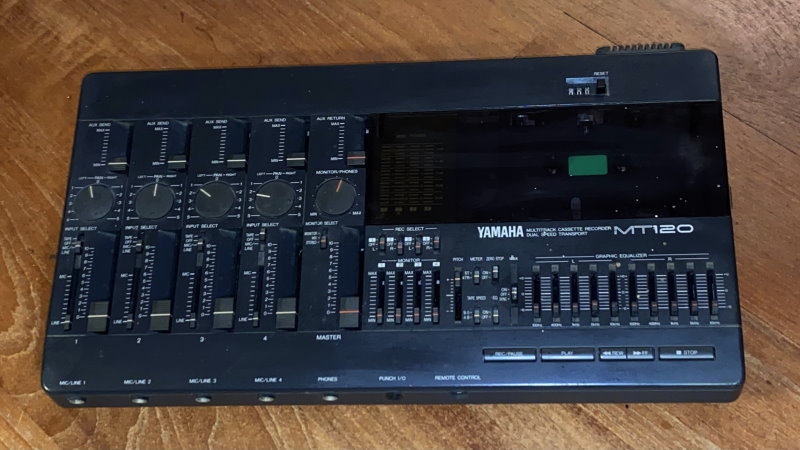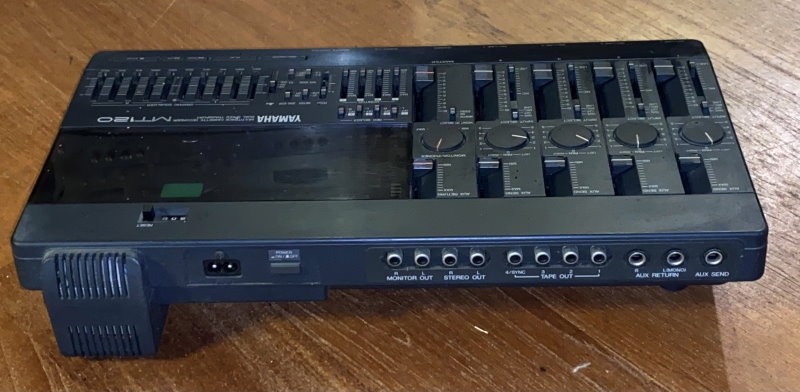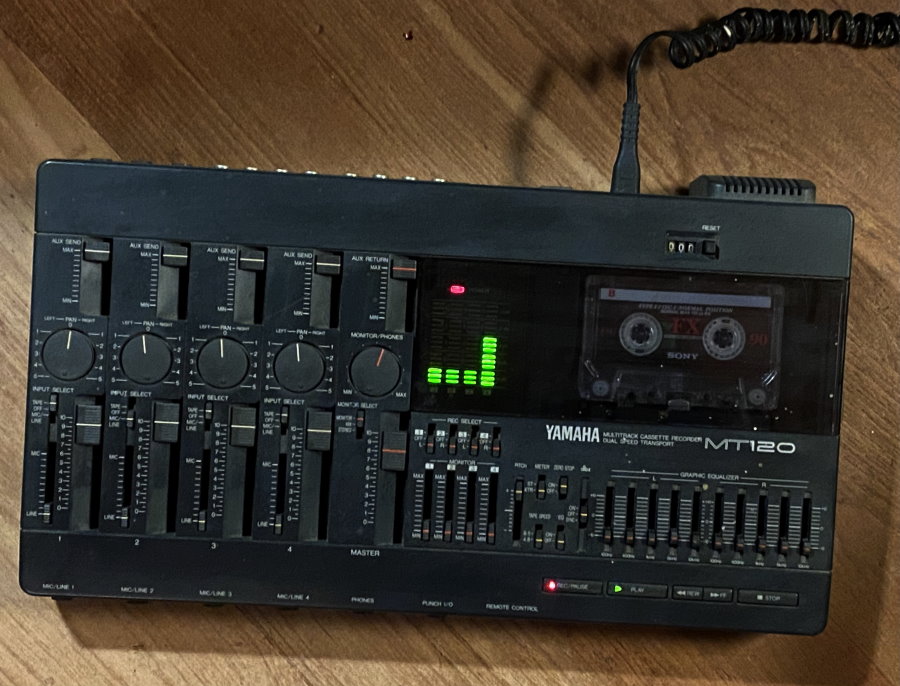



YAMAHA MT120 Multitrack Cassette Recorder Dual speed Transport. Excellent and perfect working conditions Code EF10
For your new analog recording performances, the SOUND you were looking for in this ready-to-use, high-performance multitrack.
Te MT120 4-track cassette machine from Yamaha has a typically 'entry-level'
configuration, although its switchable normal/high-speed transport enables it to
offer superior audio performance to many models in this sector of the market.
Distinctively styled, despite the preponderance of matt-black, and of sensibly
compact dimensions, the unit closely matches most of its rivals on basic
features, but with the one unusual addition of a dual 5-band graphic EQ across
the stereo bus.
As usual with Yamaha, build quality and the general feel of the product in use
is excellent. Although this type of unit should always be intrinsically simple
to operate, in practice many examples are not. The MT120, however, never
obscures functionality with its styling, and introduces no non-standard
multitracking procedures or terminology; full marks for that. Less satisfactory
though is the fact that Yamaha seem to have overlooked the possible requirement
for additional inputs into the stereo bus for sequenced MIDI sources being run
'live' into the mix. This is now acknowledged, to some extent, by most other
manufacturers' entry-level designs, even if they don't all go as far as Fostex's
X28. The curious thing about the MT120 is that there is a way in which you can
actually achieve a respectable nine sources at mixdown; however, you'd never
know that unless you were inclined to go looking for it. The manual makes no
reference to the possibility! I'll explain later.
Unusually for a compact-chassis recorder, the MT120 utilises an on-board power
supply, with detachable mains lead (dual round-pin, reversable-polarity
connector). Yet again, however, access for the all-important cleaning and
de-magnetising processes is hindered by the flip-up cover for the cassette
housing, which only tilts up to about 45 degrees. Surely it can't be too
difficult to design a cover that is readily detachable, or which tilts back
right out of the way?
INPUTS
The MT120 offers four main fader-controlled inputs, plus a stereo aux return,
although the channel facilities are restricted to just pan and auxiliary send
controls. The only EQ provided is via the stereo bus, but as this can be used as
a tape send, it is possible to EQ individual signals during recording, but not
on mixdown — now a fairly common configuration in this type of unit. The MT120's
EQ is a bit more sophisticated than most however, offering +/-10dB at each of
five bands: 100Hz; 400Hz; 1kHz; 5kHz; 10kHz ('Q' = 0.7). You can certainly do a
bit more with it than just basic sweetening or 'top-loss pre-compensation'.
Although all the faders are centre-detented at the flat position, the entire EQ
stage can be switched out, when necessary — switching-in with everything set
flat introduces no undue noise.
Input from the four 1/4" jacks along the front edge of the chassis is controlled
by a mic/line gain sensitivity slider next to the main fader. Channel source
switching selects either mic/line or the off-tape signal at the input, with the
track record-select logic determining the destination. Pan is via large rotary
controls, whilst the channel auxiliary offers a post-fader effect send facility
via a short-throw fader.
NOISE
The input amplifier stage performs well enough, provided you stick to line-level
or close-miked sources, and follow the manual's sensible guidelines on
maximising headroom. With the powerful dbx noise-reduction system employed (NR
can be switched out on track 4 for sync code usage), tape noise is reduced to
the point where input noise is often more significant. You can certainly be a
little more conservative than normal with levels onto tape.
If you go looking for problems with the dbx, you will find them; record either a
bass drum or a bass guitar (particularly one with very little mid or HF content)
on its own and you will hear a small burst of unmasked tape noise accompanying
every note or hit, if you are monitoring loud enough. This is an inevitable
consequence of employing the dbx system's full-range compander approach in an
inherently noisy situation, and much is made of it by the makers of rival NR
systems.
Personally I am inclined to say "so what"; how often in 4-track recording do you
actually get to record a bass drum on its own track? Most of the time the input
signal will have enough HF content to effectively mask noise shadowing. If you
are sequencing bass and drums anyway, and recording only signals such as vocals
and guitars on tape, then so much the better, and you might as well have the
advantage of minimal tape noise that the dbx system offers — in normal usage I
think the benefits easily outweigh the occasional side-effect.
Both electronically, and off-tape, the MT120 is a very quiet machine compared to
some of its competitors, achieving 85dB s/n ratio (3% THD) and 40Hz to 18kHz
(+/-3dB) frequency response, at the higher (9.5cm/sec) tape speed
setting.Although the MT120 has only a very basic mechanical tape counter, there
are four decent (15-segment) bargraph meters, switchable between track and
stereo bus levels. The electronic transport control logic provides 'cue'
monitoring when a wind mode is entered from Play without going via Stop.
Zero-return is incorporated, but no zero-return-and-play for some reason; surely
this is fairly basic? The optional RCM1 remote control unit (wired) was supplied
with the review set-up. Considering the size of the hand-set, its transport
controls are ludicrously small. I don't suppose anybody knows why they are not
simply a duplicate of those on the machine itself which are a far more
operationally convenient size?